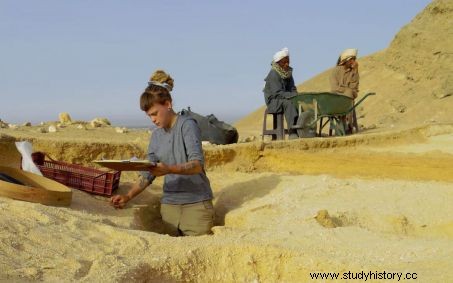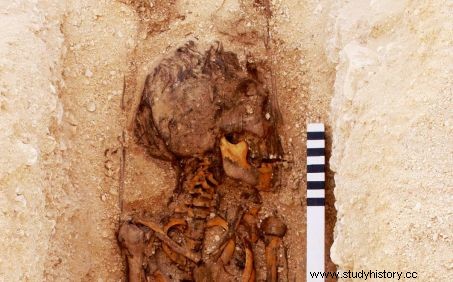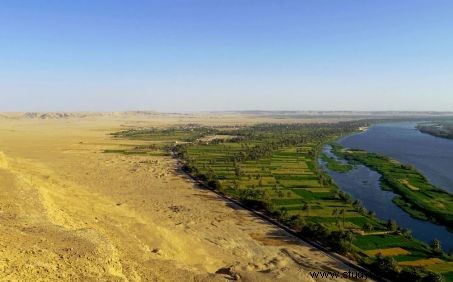Recent discoveries made in an ancient cemetery in Amarna, Egypt, question the conditions in which the capital of Akhenaten, the father of Tutankhamun, was really built.

Akhenaten, by his reign name Amenophis IV (Neferkheperure) reigned over Egypt for 17 years.
In year 5 of his reign, Akhenaten (Amenhotep IV), the famous "heretic" pharaoh ascended the throne in 1346 BC, had, in his spectacular break with the old order, built a new quoted at Tell el-Amarna, in the middle of the desert, 300 km from Thebes, the religious capital of his predecessors. From a nothingness of dunes, in barely 15 years, he had raised from the sands a complete city, with its palaces, its temples, and its sanctuaries dedicated to Aten, the unique sun god that the sovereign of the XVIII and dynasty then tried to impose to eclipse the old deities.

The city of Tell el-Amarna reconstructed in 3D. © Archéovision - Archéotransfer
But large parts of the reign of the man who was the husband of Nefertiti and the father of Tutankhamun are still largely unknown. Hence the importance of the discovery reported in the British daily The Guardian and its June 6, 2017 edition by archaeologist Mary Shepperson of University College London (UCL) which casts a veil of shadow over the biography of the illustrious philosopher monarch. Indeed, after studying two important cemeteries unearthed between 2006 and 2013, researchers from the Amarna Project* have made some very strange discoveries.

Excavations in the deep graves of Amarna North Cemetery. © Mary Shepperson / Amarna Project
If the remains found in the tombs of the South cemetery did not present any notable particularities, apart from an absence of human remains of people over 50 years old, it was not the same in the North cemetery where only skeletons of children, teenagers and young adults were found, buried in humble braided mats. "Unusual and somewhat scary results says Mary Shepperson.

One of the skeletons of children found in Amarna North Cemetery. © Mary Shepperson / Amarna Project
All were the subject of analyzes conducted by Gretchen Dabbs, an anthropologist specializing in forensic medicine, at the Southern Illinois University of Carbondale (United States). This work revealed that out of a set of 105 individuals, more than 90% were between 7 and 25 years old and that the majority of them were around 15 years old. Age groups which are usually not legion in cemeteries... Disturbing clues, the pathologies detected were those of trauma and degenerative conditions. “10% had developed osteoarthritis and “16% of under 15s had spine fractures “, explains the author of the study, or anomalies associated with very hard work. How can these peculiarities be explained? “Perhaps these are young people used as slave labour “, explains Marc Gabolde, Egyptologist, professor at Paul-Valéry-Montpellier III University, contacted by Sciences et Avenir.

One of the graves containing up to six bodies of young adults exhumed in the North Cemetery. © Mary Shepperson / Amarna Project
Found not far from stone quarries, they may have been employed during the frenetic construction of El Amarna, as part of forced labor. "No one was rushing to come and work in El Amarna!" continues the expert, specialist in the 18 th dynasty. The site was far from everything and we know that the sovereign had offered houses and tombs there for servants to settle there ". And those kids? Were they Egyptians? Come from somewhere else? Only DNA or strontium isotopic analyzes – which provide valuable information on territorial movements – could one day answer these questions. In ancient Egypt where family ties were very important, these children buried alone, or in mass graves, seem to have found themselves far from their families. “The North Cemetery forces us to face the possibility that Akhenaten built his city at least in part with child labor “, risks Mary Shepperson. It remains to be seen whether such practices prevailed in other places in New Kingdom Egypt, or were specific to Tell el-Amarna. Because such discoveries had never been made.

View of the ruins of the city of Amarna, from the northern cliffs. © Mary Shepperson / Amarna Project
Abandoned at the death of Akhenaten (1329 BC), barely 15 years after the start of its construction, Tell el-Amarna, the city of the "monotheistic" pharaoh, seems to have carried away less glorious secrets in the sands.
* The Amarna project, depends on the Mc Donald Institute for Archaeological Research, University of Cambridge, England.
